Barber J.R. Intermediate Mechanics of Materials
Подождите немного. Документ загружается.


3.5 The principle of stationary potential energy 115
Notice that the constant
Ω
0
representing the potential energy in the horizontal
position, disappears on differentiation. The value of
Ω
0
is therefore of no importance
to the calculation and the datum for potential energy can be chosen arbitrarily.
7
We can also determine the stability of the deformed configuration by performing
a second differentation. We obtain
∂
2
Π
∂
u
C
2
=
5k
4
.
Since springs must have positive stiffnesses, this derivative is positive and it follows
that equation (3.40) defines a minimum of total potential energy and hence a stable
equilibrium configuration. We shall return to the question of stability of elastic sys-
tems in Chapter 12. The remainder of this chapter will be limited to the use of energy
methods in the determination of equilibrium configurations.
3.5.1 Potential energy due to an external force
Example 3.4 was formulated in terms of gravity, since the concept of gravitational
potential energy will be familiar to many readers from elementary physics and dy-
namics. However, the problem would be essentially unchanged if the bar, instead of
having mass M, were subjected to a vertical external force F of magnitude Mg at its
mid-point B. The displacement could then be written in terms of F as
u
C
=
2F
5k
.
We can generalize the idea of the potential energy to describe the effect of an
external force F in any direction. The potential energy of such a force is
Ω
= −F · u , (3.41)
where u is the displacement of its point of application from some fixed datum. Thus,
Ω
is the work done against the force during the deformation. The force is assumed to
be constant
8
and apply throughout the motion, so if the deformation were reversed,
this work would be recovered and is therefore legitimately defined as potential en-
ergy.
3.5.2 Problems with several degrees of freedom
In Example 3.4, the bar has only one degree of freedom. Once u
C
is specified, the
position of the bar and hence the extensions of the two springs are defined. The
position of the bar could alternatively have been characterized using the angle
θ
7
See footnote 5 on page 110.
8
Notice once again that there is no factor of 1/2 in this expression, since the force remains
constant throughout the deformation, in contrast to that in a spring which increases linearly
from zero during extension.
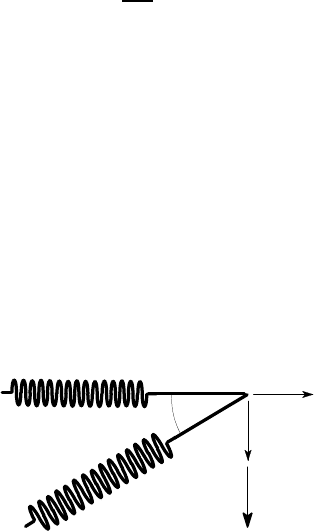
116 3 Energy Methods
from the horizontal (see Figure 3.10 (b)). We would then have to determine the strain
energy and potential energy in terms of
θ
instead of u
C
and the statement of the
principle of stationary potential energy would be written
∂Π
/
∂θ
=0. The same final
result would be obtained.
A good strategy is to sketch the system in a representative deformed configu-
ration and then determine the minimum number N of independent displacements
and/or angles needed to define the configuration completely. We shall refer to these
displacements and/or angles as the degrees of freedom of the system and refer to
them as u
i
, where i = (1,N). In view of the above discussion, it is clear that the
choice of the u
i
is not unique, but the number of degrees of freedom N must be the
same whatever choice is made.
The degrees of freedom u
i
completely define the deformed configuration and
hence they also define the extended length of all springs and the distance moved by
all external forces. We can therefore write the strain energy and potential energy in
terms of the u
i
. The principle of stationary potential energy is then written in the
form that the partial derivative of
Π
with respect to each degree of freedom must be
zero — i.e.
∂Π
∂
u
i
= 0 (3.42)
for i=(1,N). This provides N equations to determine the N unknowns u
i
, and hence
determine the deformed configuration of the system.
Example 3. 5
Determine the horizontal displacement of the point A for the structure of Figure
3.5(a), loaded by a vertical force F.
This system has two degrees of freedom, since (i) we need two coordinates to
define the position of the point A and (ii) the springs are extensible so there are no
kinematic constraints on this position within the plane. The choice of degrees of
freedom is arbitrary, but a convenient choice is to take the horizontal and vertical
displacements of A as u
1
,u
2
respectively, as shown in Figure 3.11.
F
30
o
A
1
k
2
k
2
u
u
1
Figure 3.11: Displacements of the point A
With these displacements, the potential energy of the force F is
Ω
= −Fu
2
.
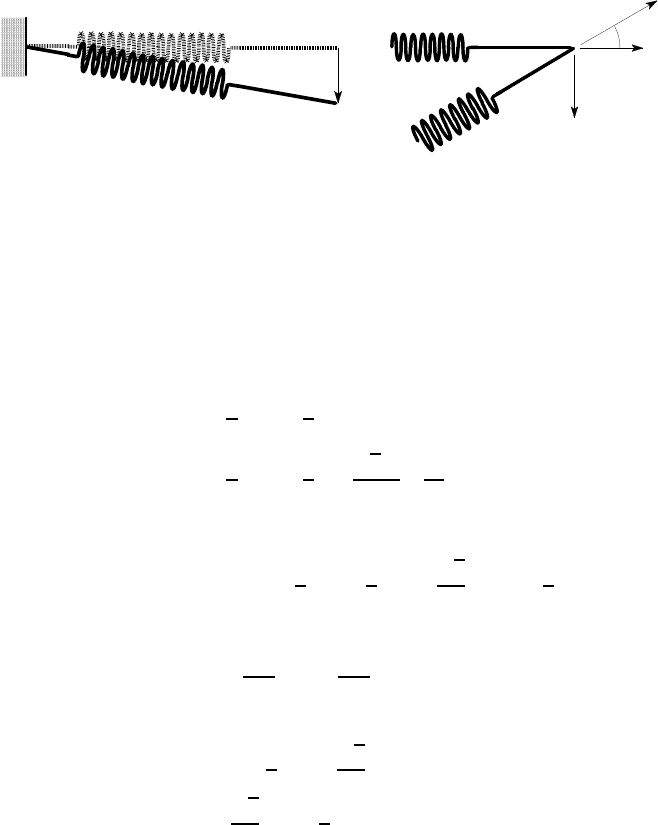
3.5 The principle of stationary potential energy 117
To find the strain energy stored in the two springs in terms of the two degrees
of freedom u
1
,u
2
, we need to use kinematic arguments to find the extensions of the
springs.
If the displacements u
1
,u
2
are small in comparison with the original lengths of
the springs, the change in length of each spring depends only on that component
of displacement parallel to the spring. For example, the horizontal displacement u
1
causes an increase in length
δ
1
= u
1
in spring 1, but the vertical displacement u
2
causes no increase in length. Instead, it simply causes spring 1 to rotate about its
fixed support through a small clockwise angle, as shown in Figure 3.12 (a).
A
1
k
u
2
30
o
A
1
k
2
u
u
1
δ
2
2
k
(a) (b)
Figure 3.12: Kinematics of spring extension
Similarly, the extension
δ
2
of spring 2 depends only on the component of dis-
placement parallel to spring 2. We can find this by resolving the components u
1
,u
2
into this direction, as shown in Figure 3.12 (b), with the result
δ
2
= u
1
cos30
o
−u
2
sin30
o
.
We can now write the strain energy in the two springs as
U
1
=
1
2
k
1
δ
2
1
=
1
2
k
1
u
2
1
U
2
=
1
2
k
2
δ
2
2
=
1
2
k
2
√
3u
1
2
−
u
2
2
!
2
.
Collecting results, we have
Π
=
Ω
+U
1
+U
2
= −Fu
2
+
1
2
k
1
u
2
1
+
3
8
k
2
u
2
1
−
√
3
4
k
2
u
1
u
2
+
1
8
k
2
u
2
2
.
The principle of stationary potential energy now gives the two equations
∂Π
∂
u
1
= 0 ;
∂Π
∂
u
2
= 0 ,
from which
k
1
u
1
+
3
4
k
2
u
1
−
√
3
4
k
2
u
2
= 0 (3.43)
−
√
3
4
k
2
u
1
+
1
4
k
2
u
2
−F = 0 . (3.44)

118 3 Energy Methods
The solution of these equations is
u
2
=
3
k
1
+
4
k
2
F ; u
1
=
√
3F
k
1
. (3.45)
Notice that the vertical displacement u
2
is the same as we obtained in §3.3 [equa-
tion (3.21)], as we should expect, but the earlier method (equating the work done by
the force to the total strain energy stored) was unable to give a value for the horizontal
displacement u
1
.
Notice also that the same equations (3.43, 3.44) could have been obtained by
finding the forces in the springs from their extensions and then writing two equilib-
rium equations for the pin at A. The forces in the springs are given by
F
1
= k
1
δ
1
= k
1
u
2
F
2
= k
2
δ
2
= k
2
(u
1
cos30
o
−u
2
sin30
o
) .
Substituting these results into the equilibrium relations (3.16, 3.17) for the pin at A,
we obtain (3.43, 3.44) as before.
3.5.3 Non-linear problems
In developing the principle of stationary potential energy, we appealed to the idea that
a system cannot escape from a minimum energy state unless some external energy
source is provided. This argument makes no assumptions about linearity and hence
the principle can be applied to non-linear systems, provided the components are all
elastic.
9
Non-linear effects can arise in mechanics problems from two sources. Material
non-linearities occur if the components are constructed from non-linear elastic ma-
terials — i.e. materials for which stress and strain are not linearly related, but which
do follow the same curve on loading and unloading. Geometric non-linearities arise
when the displacements are no longer small in comparison with the dimensions of
the structure. In both cases, the principle of superposition fails — i.e. when two loads
are applied to a structure, the deformation is not generally equal to the sum of that
produced by each load acting separately.
The application of the principle of stationary potential energy involves the same
steps as in linear problems, but of course the non-linearity of the resulting equations
generally leads to more complicated algebra.
Example 3. 6
Figure 3.13 (a) shows a mass M which is free to slide in a frictionless vertical groove
and attached to a spring. The spring is unstretched in the horizontal configuration
9
This condition is important since for inelastic components, some of the work done during
loading is dissipated as heat and is not recoverable on unloading.
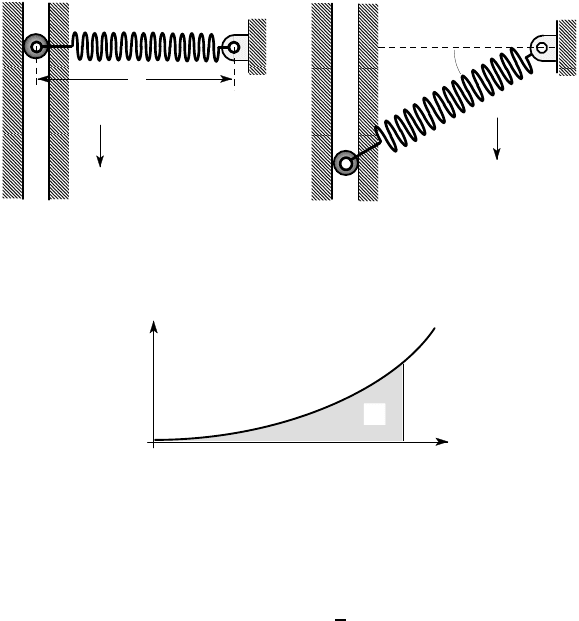
3.5 The principle of stationary potential energy 119
of Figure 3.13 (a) and has a non-linear relation between tensile force F and the
extension u given by
F = Cu
2
,
as shown in Figure 3.14. Find the equilibrium configuration of the system.
(a) (b)
Figure 3.13: Mass constrained by a groove and supported by a non-linear spring
F
O
u
2
F = Cu
W
Figure 3.14: Force extension curve for the non-linear spring
As in equation (3.1), we can compute the strain energy stored in the spring by
equating it to the work done during extension, with the result
U =
Z
u
0
Cu
2
du =
1
3
Cu
3
. (3.46)
The mass has one degree of freedom which we shall characterize by the angle
θ
between the spring and the horizontal in the deformed position, as shown in Fig-
ure 3.13 (b). We shall make no assumptions about smallness of the deformations
and hence the problem exhibits both material and geometric non-linearity. In the
deformed position, the potential energy of the mass is
Ω
= −MgL tan
θ
and the deformed length of the spring is Lsec
θ
, corresponding to an extension
u = L(sec
θ
−1) .
Substituting into equation (3.46), we obtain
g
M
L
g
M
θ

120 3 Energy Methods
U =
1
3
CL
3
(sec
θ
−1)
3
and hence
Π
= U +
Ω
=
1
3
CL
3
(sec
θ
−1)
3
−MgL tan
θ
.
The equilibrium configuration is then determined from the condition
∂Π
∂θ
=
CL
3
(sec
θ
−1)
2
sin
θ
cos
2
θ
−
MgL
cos
2
θ
= 0
and hence
sin
θ
(sec
θ
−1)
2
=
Mg
CL
2
,
which can be solved numerically for
θ
.
3.6 The Rayleigh-Ritz method
To use the principle of stationary potential energy, we have to characterize the kine-
matics of the deformation in terms of a finite number of degrees of freedom u
i
and
this can only be done for systems consisting of rigid bodies connected by springs. By
contrast, a continuous elastic body (e.g. a laterally-loaded beam) has an infinite num-
ber of degrees of freedom, because it is capable of being deformed into an infinity of
different shapes by appropriate external loads.
However, we can use the principle of stationary potential energy to develop an
approximate solution to the problem. We first assume some approximate form for
the solution, containing a number of arbitrary constants, which constitute the degrees
of freedom in the solution. We then use the stationary potential energy theorem to
determine ‘optimal’ values for these constants. This is known as the Rayleigh-Ritz
method. It is similar to the process of fitting the best curve to a set of data points,
where ‘best’ is here interpreted in the sense of minimizing some measure of error,
such as the sum of the squares of the shortest distances from the points to the line (the
so-called ‘least squares’ fit). The principle of stationary potential energy provides a
natural criterion for choosing the best approximation in a given class.
By approximating the deformation by an expression with a finite number of de-
grees of freedom, we are constraining the solution to lie in a subset of the actually
infinite number of kinematically possible states of deformation. The accuracy of the
resulting approximation will clearly depend on the choice of this subset. There are
no deterministic rules for choosing an appropriate approximate form, other than the
requirement that it should satisfy the kinematic boundary conditions of the problem.
The best strategy is to rely on our ‘non-engineering’ intuition (see Chapter 1) to
sketch the expected deformed shape of the body and only then seek a mathematical
expression that can describe this shape. We shall give various examples of this pro-
cess and its effect on the accuracy of the resulting approximation in the following
pages.
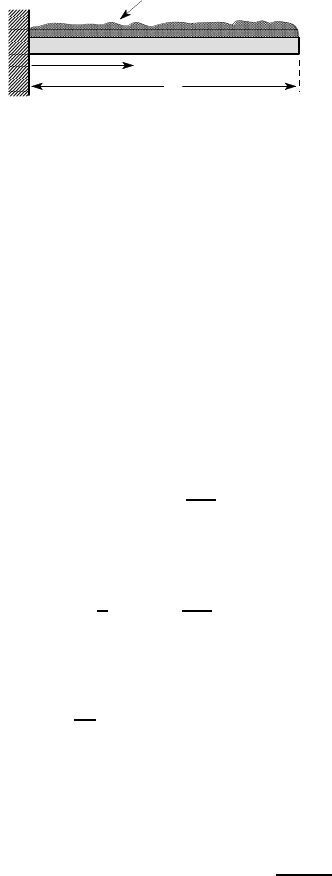
3.6 The Rayleigh-Ritz method 121
Example 3. 7
A cantilever beam is built-in at z = 0 and subjected to a uniformly distributed load
w
0
per unit length, as shown in Figure 3.15. Use the Rayleigh-Ritz method to find an
approximate expression for the deflection of the beam.
Figure 3.15: Cantilever subjected to a uniform lateral load
Clearly, the beam will bend downwards, but for consistency with other beam
problems in Chapters 4,7,12, we shall use the sign convention that positive dis-
placements u(z) are upwards. The slope and deflection must be zero at z = 0 —
i.e. u(0) = u
′
(0) = 0 — so we assume the simplest polynomial approximation that
satisfies these conditions, which is
u = Cz
2
. (3.47)
This is a one term approximation — i.e. there is only one degree of freedom, rep-
resented by the constant C which must be determined by applying the principle of
stationary potential energy.
In order to determine the strain energy, we need to express equation (3.24) in
terms of the displacement, rather than the bending moment. Noting that
M = −EI
d
2
u
dz
2
from the elementary bending theory, and substituting for M into (3.24), we obtain
U =
1
2
Z
L
0
EI
d
2
u
dz
2
2
dz . (3.48)
Substituting for u from equation (3.47) and evaluating the integral, we find
U =
EI
2
Z
L
0
(2C)
2
dz = 2EIC
2
L .
The potential energy of the external load
Ω
can be found by thinking of the load
as a set of concentrated forces, w
0
dz, each of which moves downwards through a
distance (−u), since the sign convention for u is positive upwards. Thus,
Ω
=
Z
L
0
w
0
u(z)dz = w
0
Z
L
0
Cz
2
dz =
w
0
CL
3
3
.
The total potential energy is therefore
w per unit length
0
A
B
z
L
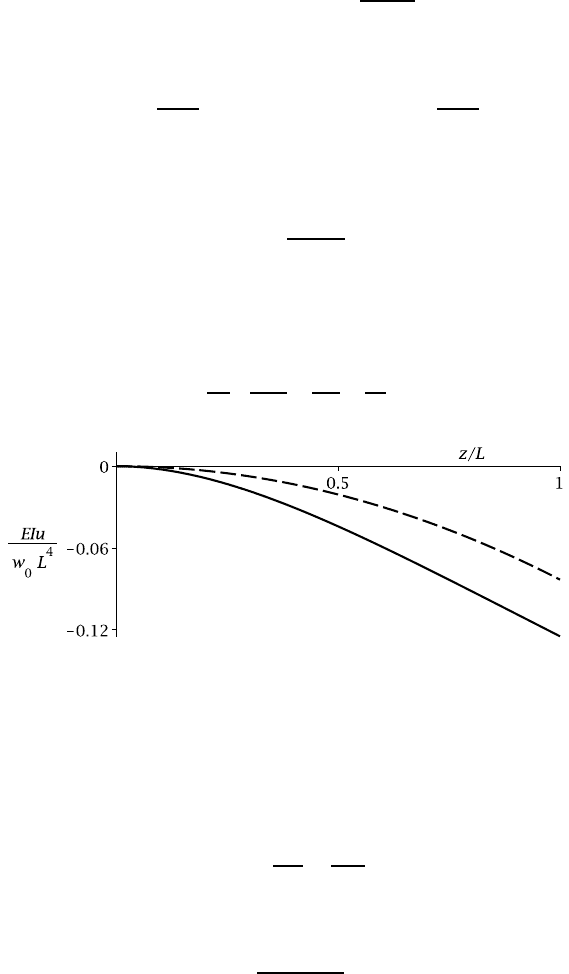
122 3 Energy Methods
Π
= U +
Ω
= 2EIC
2
L +
w
0
CL
3
3
and the principle of stationary potential energy
∂Π
/
∂
C =0 then gives
4EICL +
w
0
L
3
3
= 0 and hence C = −
w
0
L
2
12EI
.
Substituting this result into equation (3.47), we obtain the approximate solution for
the displacement of the beam as
u(z) = −
w
0
L
2
z
2
12EI
. (3.49)
Of course, this problem can very easily be solved exactly by using equilibrium
arguments to find the bending moment and then integrating the bending moment-
curvature relation. The exact expression for the displacement is
u = −
w
0
EI
L
2
z
2
4
−
Lz
3
6
+
z
4
24
. (3.50)
Figure 3.16: Comparison of exact and approximate solutions for u(z)
The exact and approximate deflection curves are compared in Figure 3.16. The ap-
proximate expression significantly underestimates the actual deflection. For example,
it predicts only two thirds of the correct displacement at the free end B. The approx-
imation is even poorer in other more detailed respects. For example, it is based on a
constant curvature along the beam and hence implies a constant bending moment
M = −EI
d
2
u
dz
2
=
w
0
L
6
,
whereas the actual bending moment is a function of z given by
M =
w
0
(L −z)
2
2
.
Thus, the approximation underestimates the maximum bending moment (at z = 0) by
a factor of 3.

3.6 The Rayleigh-Ritz method 123
These results are fairly typical for a Rayleigh-Ritz approximation with only one
degree of freedom. The approximation will generally be found to underestimate max-
imum deflections by anything up to 50% and significantly larger errors will be found
in estimates for force resultants or stresses. The underestimate is associated with the
fact that the assumed approximate form constrains the permitted shape of the body
and hence tends to produce a stiffening effect. The true equilibrium state must have a
lower total potential energy than the approximate one and this implies that if the con-
straint is relaxed, the external loads will lose potential energy by moving in their own
directions. This trend will also be apparent if the constraint is partially removed by
the addition of one or more additional degrees of freedom. Thus, the addition of an
extra degree of freedom always moves the total energy nearer to the true equilibrium
state and hence is associated with an improvement in accuracy.
10
There are ways to improve the accuracy of the Rayleigh-Ritz approximation
without making the calculation significantly more complicated, but we should not
underestimate the value of a method that can produce an estimate even within 50%
of the correct result using such a simple procedure. In this context, we note
(i) In the early stages of the design process, we often want just an order of magni-
tude estimate of a physical quantity, to determine which components, quantities
or locations are critical in the proposed design and hence whether the concept
is feasible (see Chapter 1). When these strategic questions have been answered,
there are many techniques available (all of course much more time consuming)
for getting more accurate predictions for the limited number of quantities that
have been identified as critical.
(ii) Although the numerical values obtained from the method are grossly approx-
imate, the parametric form is correct. For example, equation (3.49) correctly
predicts that the maximum deflection will be a numerical multiple of wL
4
/EI.
This is very useful in the design process, since it gives us a good indication of
what changes in the design parameters will be beneficial and how much effect
they will have. By contrast, similar information can be obtained from purely nu-
merical methods only by performing multiple solutions for different parameter
values and analyzing the results.
(iii) In Example 3.7, the exact solution is not much more difficult than the approx-
imate one and we have deliberately made this choice to enable simple compar-
isons to be made. To get a more realistic idea of the relative simplicity of the
method, the reader should consider a more complex problem such as Problem
3.20. The exact solution for this indeterminate problem would involve the use of
singularity functions and the imposition of boundary conditions would then lead
to a set of simultaneous algebraic equations. By contrast, the Rayleigh-Ritz so-
lution would be only marginally more complicated than Example 3.7. In fact, the
reader is recommended to think through the procedure involved in a conventional
solution to any of the problems he/she solves using any of the energy methods
10
This is one of the major advantages of the use of total potential energy as a criterion for
the ‘best’ approximation. It ensures that the addition of extra degrees of freedom always
improves the approximation, regardless of the choice of form.
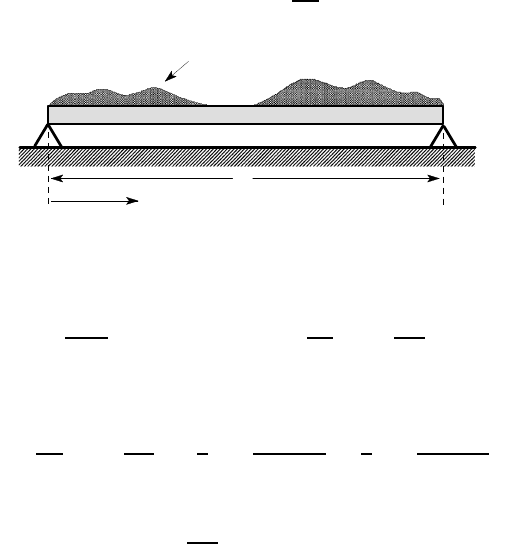
124 3 Energy Methods
treated in this chapter, in order to develop a sense of the relative advantages of
the various methods in different contexts.
3.6.1 Improving the accuracy
The obvious way to improve the accuracy of a Rayleigh-Ritz approximation is to
use a representation with more degrees of freedom. From an algebraic point of view,
there are practical limits to this process. We saw in Example 3.5 that even the use
of two degrees of freedom significantly increases the complexity of the solution and
it largely defeats the object of the excercise to use more than two. The only excep-
tions to this rule are those in which the terms corresponding to additional degrees of
freedom can be described in a suitably condensed notation, such as a series.
Series solutions
Consider, for example, the simply-supported beam of Figure 3.17, subjected to a dis-
tributed load w(z). A fairly general approximation to the deformed shape, satisfying
the end conditions u(0)=u(L)= 0 can be written in terms of the Fourier series
u(z) =
N
∑
i=1
C
i
sin
i
π
z
L
. (3.51)
Figure 3.17: Simply-supported beam subjected to arbitrary loading w(z)
The strain energy is then found by substituting (3.51) into (3.48), with the result
U =
EI
π
4
2L
4
N
∑
i=1
N
∑
j=1
i
2
j
2
C
i
C
j
Z
L
0
sin
i
π
z
L
sin
j
π
z
L
dz . (3.52)
To evaluate the integral, we use the results
sin
i
π
z
L
sin
j
π
z
L
=
1
2
cos
(i − j)
π
z
L
−
1
2
cos
(i + j)
π
z
L
Z
L
0
cos
n
π
z
L
dz = 0 ; n 6= 0
= L ; n = 0 , (3.53)
L
z
w(z) per unit length
